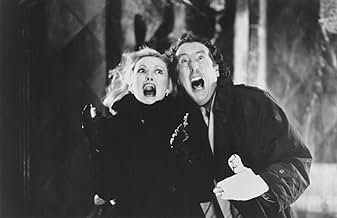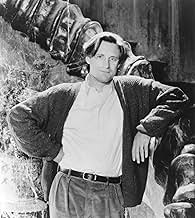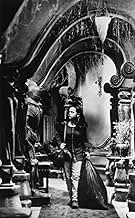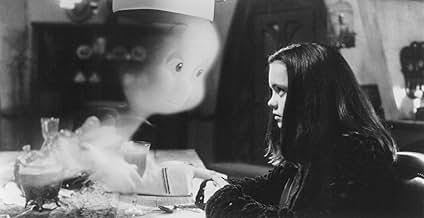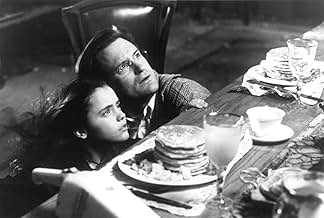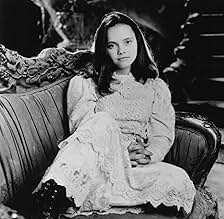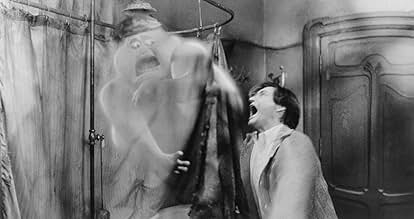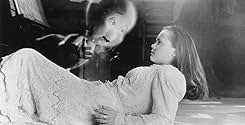Casper
- 1995
- Tous publics
- 1h 40m
An afterlife therapist and his daughter meet a friendly young ghost when they move into a crumbling mansion in order to rid the premises of wicked spirits.An afterlife therapist and his daughter meet a friendly young ghost when they move into a crumbling mansion in order to rid the premises of wicked spirits.An afterlife therapist and his daughter meet a friendly young ghost when they move into a crumbling mansion in order to rid the premises of wicked spirits.
- Director
- Writers
- Stars
- Awards
- 5 wins & 5 nominations total
Malachi Pearson
- Casper
- (voice)
Fred Rogers
- Mr. Rogers
- (archive footage)
- (as Mr. Rogers)
Doug Bruckner
- Reporter
- (voice)
- (as Douglas J.O. Bruckner)
Joe Nipote
- Stretch
- (voice)
Joe Alaskey
- Stinkie
- (voice)
Brad Garrett
- Fatso
- (voice)
John Kassir
- The Crypt Keeper
- (voice)
- Director
- Writers
- All cast & crew
- Production, box office & more at IMDbPro
Featured reviews
Forget the story. Forget the characters; forget even the kids and rent this just to be able to see Whipstaff Manor.
For me a film can be rewarding if just one element (in practical terms, it has to be an element I can recognize) is best in class. Here, it is the absolutely engaging set.
At the end of the 19th century, a style of art, essentially a fad, swept over Europe: Art Nouveau. This focused on natural forms and continuous lines. Done well in drawing and sculpture, its quite charming. At the same time, there was a crisis in architecture as the first real architects sought solutions to how internal space affects the psyche. For only a decade or so, architects tried to employ art nouveau in their work.
The problem is that the two just don't naturally mix: it's as if someone tried to do a swimmingpool production of Hamlet. But two geniuses partly succeeded in a few experiments: Horta in Brussels and Gaudi in Barcelona. In their lives their experiments were rejected by the public and critics. Today, they are among only a few valued gems of modern architectural history we have.
So much for background. What we have in Whipstaff Manor is a reworking of Gaudi, with some elements of Horta in entry and staircase. This is notable for a couple reasons:
---The primary mission of a film is to convey a tone, ideally an unfamiliar one. Sometimes cinematography is the tool of reliance, sometimes costumes, sometimes surreal plot twists, rarely acting posture. Rarely, rarely is the set the star. The goal of Gaudi was to (in a very literal sense) raise spirits by the form of the space. See how you feel in the bedroom/corridor and `livingroom' spaces. The attic was done by a lesser talent and the cellar isn't part of this discussion. But the main house draws on some deeply spooky center of the mind.
---The second notable comment is the sheer difficulty of what the set designers have done. Gaudi, an absolute master, had difficulty pulling off what he did. Here, the Casperites had an even greater challenge: when I go in a space, the relationship between me and the space is intimate; just a simple dialog. But when the space is presented through a medium, the designers have to dramatically exaggerate elements so the combined effect appears `normal.' Its the same as with what actors must do as compared to ordinary people you encounter; but an environment is more complex, more multidimensional, less semiotically loaded than a person. Mastering this greater palette of form is remarkable, and that's before you even accommodate the physical needs of production (camera placement, sound wiring...)
Check this out; it's interesting. Just based on the set, I place this in my best films list.
For me a film can be rewarding if just one element (in practical terms, it has to be an element I can recognize) is best in class. Here, it is the absolutely engaging set.
At the end of the 19th century, a style of art, essentially a fad, swept over Europe: Art Nouveau. This focused on natural forms and continuous lines. Done well in drawing and sculpture, its quite charming. At the same time, there was a crisis in architecture as the first real architects sought solutions to how internal space affects the psyche. For only a decade or so, architects tried to employ art nouveau in their work.
The problem is that the two just don't naturally mix: it's as if someone tried to do a swimmingpool production of Hamlet. But two geniuses partly succeeded in a few experiments: Horta in Brussels and Gaudi in Barcelona. In their lives their experiments were rejected by the public and critics. Today, they are among only a few valued gems of modern architectural history we have.
So much for background. What we have in Whipstaff Manor is a reworking of Gaudi, with some elements of Horta in entry and staircase. This is notable for a couple reasons:
---The primary mission of a film is to convey a tone, ideally an unfamiliar one. Sometimes cinematography is the tool of reliance, sometimes costumes, sometimes surreal plot twists, rarely acting posture. Rarely, rarely is the set the star. The goal of Gaudi was to (in a very literal sense) raise spirits by the form of the space. See how you feel in the bedroom/corridor and `livingroom' spaces. The attic was done by a lesser talent and the cellar isn't part of this discussion. But the main house draws on some deeply spooky center of the mind.
---The second notable comment is the sheer difficulty of what the set designers have done. Gaudi, an absolute master, had difficulty pulling off what he did. Here, the Casperites had an even greater challenge: when I go in a space, the relationship between me and the space is intimate; just a simple dialog. But when the space is presented through a medium, the designers have to dramatically exaggerate elements so the combined effect appears `normal.' Its the same as with what actors must do as compared to ordinary people you encounter; but an environment is more complex, more multidimensional, less semiotically loaded than a person. Mastering this greater palette of form is remarkable, and that's before you even accommodate the physical needs of production (camera placement, sound wiring...)
Check this out; it's interesting. Just based on the set, I place this in my best films list.
There's something enormously touching about this film and the way it deals with losses -- Pullman's wife and Casper's mother, in particular. And what's so clever about it is how it uses them as a tool of audience manipulation AND has the evil ghosts use Pullman in exactly the same way that we're being used. This is a smartly written screenplay. The story itself is pretty conventional and predictable: the loner girl gets teased by a popular girl (that nobody really likes) who's out to destroy her; the popular girl has a cute boyfriend that the loner girl has the hots for, etc. etc., story will resolve itself with everyone falling in love with loner girl.
I can't quite understand why this movie has such a low rating. The only explanation I can think of is that people prefer emotionally "safe" movies like "Toy Story" (of the same year) that are equally brilliant technically (and have as many references), but don't sacrifice coolness by showing sentimental, sad emotion. It's possible that the movie got marketed incorrectly. The film isn't about spooks; like one of those early, wonderful Tim Burton fantasies (this film also shares with them an outstanding score), the film deals -- quite movingly, I think -- with regaining that lost sense of childhood: that moment where Casper tries to remember being alive is just wrenching. And the scene relates just as profoundly to us: just as he can't remember being alive, we can't, really, remember being kids. I was ten when I first saw this, and it had an effect on me then (Ricci's description of sunny side-up eggs making her gag subconsciously made me avoid anything less than hard boiled for ten years); this is something that I really cherish as being part of my young emotional and visual education, and it stands up today.
I haven't seen the director's other films, so I have no idea whether this whole thing was a fluke or whether everything just settled in to my particular sensibility, but even outside of the emotion I think the technical aspects, the giant basement set, are enough to keep interest. And even outside of that, the acting is terrific. Cathy Moriarty is an absolute riot. 7/10
I can't quite understand why this movie has such a low rating. The only explanation I can think of is that people prefer emotionally "safe" movies like "Toy Story" (of the same year) that are equally brilliant technically (and have as many references), but don't sacrifice coolness by showing sentimental, sad emotion. It's possible that the movie got marketed incorrectly. The film isn't about spooks; like one of those early, wonderful Tim Burton fantasies (this film also shares with them an outstanding score), the film deals -- quite movingly, I think -- with regaining that lost sense of childhood: that moment where Casper tries to remember being alive is just wrenching. And the scene relates just as profoundly to us: just as he can't remember being alive, we can't, really, remember being kids. I was ten when I first saw this, and it had an effect on me then (Ricci's description of sunny side-up eggs making her gag subconsciously made me avoid anything less than hard boiled for ten years); this is something that I really cherish as being part of my young emotional and visual education, and it stands up today.
I haven't seen the director's other films, so I have no idea whether this whole thing was a fluke or whether everything just settled in to my particular sensibility, but even outside of the emotion I think the technical aspects, the giant basement set, are enough to keep interest. And even outside of that, the acting is terrific. Cathy Moriarty is an absolute riot. 7/10
I don't view films as if I'm watching them as the intended audience; I watch them for myself. And that's why I found it odd at how engrossed I was when I watched this film for the first time at the age of eighteen. Aside from the great gothic flair of the mansion, two superbly placed cameos, and nice laughable black humour from the "trio," the film took off because of its emotional core. It's something that a youngster can really get into, but also anyone who finds it sad that a child can die. When Casper plays with his toys, I just wanted to start crying. This eternal child--lost and stuck in an age of mystery and wonder. And yet, he's smitten with a girl--he's starting to go through puberty. And it's just so sad . . . and beautiful.
And then there's the father, and his sway into the afterlife, his daughter's plight, her struggle with her wish to help Casper. It's all so simple and written for kids, but I was so engrossed by the romanticism of it all.
The villains mostly butt into the greatness of all of it, but you just have to grant that in a kid's picture. And now comes my but . . . in the end, when the mother does appear, she's supposed to be this amazing, angelic, deux es machinal, she floats through the stain glass window, her long hair flows around her, her gown flows all around her but--what the hell! why is her dress such a deep red!? she looks like satan! Oh well. Bad costume choice made a really bad moment. But mostly, I loved this film for it's good parts, despite the childishness of much of it.
And then there's the father, and his sway into the afterlife, his daughter's plight, her struggle with her wish to help Casper. It's all so simple and written for kids, but I was so engrossed by the romanticism of it all.
The villains mostly butt into the greatness of all of it, but you just have to grant that in a kid's picture. And now comes my but . . . in the end, when the mother does appear, she's supposed to be this amazing, angelic, deux es machinal, she floats through the stain glass window, her long hair flows around her, her gown flows all around her but--what the hell! why is her dress such a deep red!? she looks like satan! Oh well. Bad costume choice made a really bad moment. But mostly, I loved this film for it's good parts, despite the childishness of much of it.
Ever since i was six years of age, I've enjoyed this movie. It makes me laugh, cry, and excited! i am disappointed that so many people don't like this movie. it is an all-time favorite of mine. It is sad yes, but it has comic relief from the three uncles that try to be humanlike, Casper, the friendly ghost that knows what it is like to be lonely, for instance me, and same with Kat. I am very touched with this film, for it makes me think about me, lonely and depressed, but it has a positive ending which I really adored! i also liked the amazing effects, that were famous at its, time. Of course now, effects from movies are like The Matrix films and LOTR, but i mainly like this film, because it tocuhes my heart in a both sad and sometimes happy, knowing, someone else is out there for you, even if you are a bit...dead. 10/10
After you get through the stresses of your day... your job, the hassles of daily life, all the stressers that are out there daily, it seems great to sit back and enjoy something that will take you out of that for a little while. If you watch the news and read the papers every day like I do, it gets to you after a while...the young soldiers being killed in Iraq, all the election BS that we are being bombarded with right now...all or most of the news is downright depressing. That creates an important place for a movie like this...one that can make your life a little less serious for a while. I've always been a Christina Ricci fan, going back to the Addams Family when she was only 11 years old. She was a great actress even at that young age. You could tell that she would go far as an actress. The personality was there...it set her apart from her peers. At the age of 15, she continues to do a great job in Casper...she is very believable.
Sometimes, in this troubled world where violence and negative things seem to be the norm, a nice little movie like this can go a long way toward making your day a little brighter. Some of my other "feel good" movies are Patch Adams, all the Superman movies, the Robocop series, and good old Babe. Thanks for reading this. Feel free to reply with an email.
Sometimes, in this troubled world where violence and negative things seem to be the norm, a nice little movie like this can go a long way toward making your day a little brighter. Some of my other "feel good" movies are Patch Adams, all the Superman movies, the Robocop series, and good old Babe. Thanks for reading this. Feel free to reply with an email.
Did you know
- TriviaThis is the first feature film to have a fully computer-generated visual effects character in a leading role.
- GoofsCasper tells Kat that he can't hurt her, and then makes his hand go though hers to show that ghosts cannot touch living beings. Yet multiple times ghosts touch people. However, Casper hesitates before answering (notice how quickly he says that she can't hurt him), and shortly after grabs Kat to drag her out the window. Casper knows that ghosts can touch people, and may not want to scare Kat away by admitting it.
- Quotes
Dr. Raymond Stantz: [runs out of the house frantic] Who you gonna call? Someone else.
- Crazy creditsThe globe in the Universal logo fades into a full moon above Whipstaff Manor.
- ConnectionsEdited into Casper: Deleted Scene #91: Lucky Enough to Be a Ghost (2003)
- SoundtracksCasper The Friendly Ghost
Written by Mack David and Jerry Livingston
Performed by Little Richard
Produced by Richie Zito and Little Richard
Arranged by Richie Zito
Details
- Release date
- Country of origin
- Official site
- Language
- Also known as
- Casper: el fantasma amigable
- Filming locations
- Rockport, Maine, USA(Anonymous)
- Production companies
- See more company credits at IMDbPro
Box office
- Budget
- $55,000,000 (estimated)
- Gross US & Canada
- $100,544,179
- Opening weekend US & Canada
- $16,840,385
- May 28, 1995
- Gross worldwide
- $288,144,179
- Runtime
- 1h 40m(100 min)
- Color
- Sound mix
- Aspect ratio
- 1.85 : 1
Contribute to this page
Suggest an edit or add missing content



